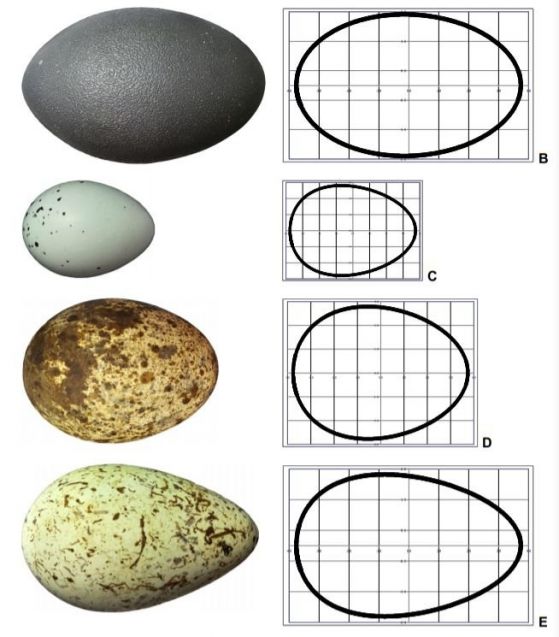Researchers at the University of Kent have discovered a universal mathematical formula that can describe any bird’s egg that exists in nature, something never before achieved.
The shape of the egg has long attracted the attention of mathematicians, engineers and biologists from an analytical point of view.
The form has been highly valued for its evolution, being large enough to incubate an embryo, small enough to come out of the body in the most efficient way, rather than rolling once laid, structurally strong enough to bear the burden and give birth to 10,500 species that survived the dinosaurs. The egg is called the “perfect shape”.
The analysis of all egg shapes uses four geometric shapes: a sphere, an ellipsoid, an egg-shaped and a pear-shaped (conical) shape with a mathematical formula of the pear-shaped shape that has yet to be derived.
The usual perception of an “egg-shaped” shape is oval, with a pointed end and a blunt end, and the widest point closest to the blunt end, somewhat like a hen’s egg. However, things can be much simpler (as in the case of spherical eggs seen in owls, for example) or much more complex (as in the case of pear-shaped eggs seen in squirrels, snipe and two of the largest species of penguins). The data show that the shape of the egg is determined before the formation of the shell and by the underlying membranes.
Why the egg is evolutionarily shaped like this is surprisingly poorly understood. That is, although there is some previous research into the development of egg shape, we do not know exactly how this process came about. In this context, the most attention in this study is drawn to pear-shaped eggs (included in this study to make the formula universal). In common snipes, the pear shape is an adaptive trait that ensures that the four eggs (invariably) “fit together” in the nest (with the pointed edges inwards) to ensure maximum incubation area under the mother.
Researchers are introducing an additional feature into the egg-shaped formula by developing a mathematical model to fit a completely new geometric shape, characterized as the last stage in the evolution of the spherical ellipsoid that is applicable to any egg geometry.
This new universal mathematical formula for egg shape is based on four parameters: egg length, maximum width, vertical axis offset and a quarter of the egg diameter.
This long-sought universal formula is a significant step in understanding not only the shape of the egg itself, but also how and why it evolved, thus making widespread biological and technological applications possible.
Mathematical descriptions of all major forms of eggs have already found application in food research, mechanical engineering, agriculture, biology, architecture and aeronautics. As an example, this formula can be applied to the engineering construction of thin-walled egg-shaped vessels, which must be stronger than typical spherical ones.
This new formula is an important breakthrough with many applications, including:
1. Competent scientific description of a biological object.
Now that an egg can be described by a mathematical formula, the work in the field of biological taxonomy, the optimization of technological parameters, the incubation of eggs and the selection of poultry will be greatly simplified.
2. Accurate and simple determination of the physical characteristics of a biological object.
The external properties of the egg are vital for researchers and engineers who develop technologies for incubating, processing, storing and sorting eggs. There is a need for a simple identification process, using egg volume, area, radius of curvature and other indicators to describe the contours of the egg provided by this formula.
3. Future engineering inspired by biology.
The egg is a natural biological system studied for the design of engineering systems and the latest technologies. The egg-shaped geometric figure has been adopted in architecture, such as the roof of the City of London and the Mary X skyscraper, and construction, as it can withstand maximum loads with minimal material consumption, to which this formula can now be easily applied.
“Biological evolutionary processes, such as egg formation, must be studied for mathematical description as a basis for research in evolutionary biology, as shown by this formula. This universal formula can be applied in key disciplines, especially in the food industry, and will serve as an impetus for further research inspired by the egg as an object of study, “said study lead author Darren Griffin. Professor of Genetics at the University of Kent.
Reference: “Egg and math: introducing a universal formula for egg shape” by Valeriy G. Narushin, Michael N. Romanov and Darren K. Grif fi n, 23 August 2021, Annals of the New York Academy of Sciences.
DOI: 10.1111 / nyas.14680
Source: The Perfect Shape? Research Finally Reveals Ancient Universal Equation for the Shape of an Egg – UNIVERSITY OF KENT
Picture: Images of eggs from the four main shapes of the following bird species: (A) ostrich, round; (B) emu, elliptical; (C) songbirds, ovoid; (D) eagle, ovoid; and (E) curry, pear-shaped; with their theoretical contours (in the right graphs). The images of the eggs were taken from Wikimedia Commons. Credit: Darren Grif et n et al.









